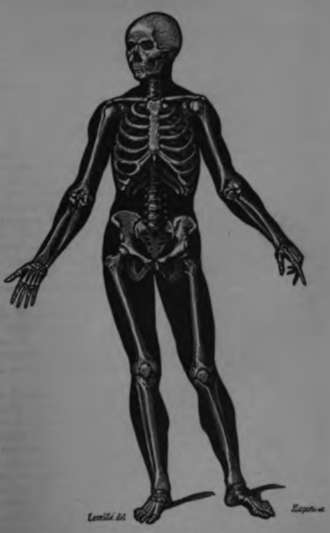Chapter III. Structure Of The Body
Description
This section is from the book "Wonders Of The Human Body", by Auguste Le Pileur. Also available from Amazon: Wonders of the Human Body.
Chapter III. Structure Of The Body
Bones
The bones are the framework of the human body. They are formed of a hard and extremely resistant tissue, and they surround more or less completely with solid walls the cavities containing delicate organs; they provide attachments and support for the soft parts, and furnish a fulcrum for the movements of the body; and lastly, by their resistance they permanently maintain the proportions between its different parts.
The osseous substance is composed of calcareous salts— phosphate or carbonate of lime—intimately combined with organic principles, the decomposition of which produces gelatine.
If the bone is immersed for a length of time in hydrochloric acid, the calcareous matter will be dissolved, and the isolated gelatine will retain perfectly the form of the bone; and in the same manner if the gelatine be destroyed by combustion, the lime which remains will show the normal form and dimensions of the bone. In a gelatinous state the bone is soft and flexible; in the calcareous state it is hard, rigid, and brittle; in a normal condition each of these constituent substances serves as a corrective to the other; and their properties united give to bone its solidity and its elastic resistance.
In the osseous tissues, as in all those of the body, we recognize a movement of composition and of decomposition, of molecules assimilated and again rejected after a certain time; but in none of the organs so well as in the bones has it been possible to demonstrate this double movement of nutrition. If we mingle madder with the food of an animal, the bones soon become red, and they regain their original colour when the colouring matter ceases to form part of the food. Or, more conclusive still, if the madder be given for a while and then omitted, and after a time be again given, the bones show a white layer between two red ones, which proves that they grow from the circumference toward the centre, by the ossification of the deepest layers of the periosteum.
The bones are divided according to their form into long, flat, and short bones. The long bones, which are first and most rapidly developed, are more dense in the middle or body of the bone than at their extremities. This body is formed principally of a compact bark or rind of ivory-like tissue, and is pierced throughout its length by the medullary canal; the extremities are composed of spongy tissue enveloped by a thin layer of ivory tissue. The long bones combine to form the limbs and the thorax; designed to serve as levers or columns, they are twisted on their axes or bent so as to offer the greatest possible resistance in exerting a force or supporting a weight.
The Flat Bones
The Flat Bones form the walls of the cavities of the cranium, of the chest, and of the pelvis; they are thinner in the middle than at the edges, and are composed of two leaves or tables of ivory tissue resting upon and confounded with each other at some points, and separated at others by a layer of spongy tissue.
The Short Bones
The Short Bones are very irregular in form and difficult to describe; very spongy in texture and relatively light. They develop later and more slowly than the others, and they are placed in groups in parts of the body where the bony frame must possess a limited power of motion, and yet be very firm, as in the foot, in the hand, and in the spinal column.
There are 198 bones in the human skeleton when it has reached its perfect development On the surface of the bones, and especially at the extremities of the long ones, there are prolongations of different forms, designed either to join the bones together, or to serve for the attachment and insertion of muscles or ligaments. These prolongations are the apophyses, which are distinguished by anatomists by names suggested by their position, by their use, or borrowed from objects of which they recall more or less exactly the form.

Fig. 11. Skeleton.
The body of the long bones and the central part of the large bones are developed before the extremities and the edges. The extremities of the long bones are cartilaginous in early life, their articulating surfaces are formed of cartilage adherent to, but not continuous with, the bone to which it belongs. This is the epiphysis, which afterward becomes ossified, but is not perfectly united to the bone till about the age of twenty. Some of the large bones also present epiphyses on their edges or borders.
A white fibrous membrane, resistant in youth and reduced to a thin layer of cellular tissue in the adult and aged, which is called the periosteum, envelops every part of the bones, except where they are covered with cartilage and where the tendons and ligaments are attached. The periosteum adheres closely to the bone, and distributes a network of vessels through its substance. Recent surgical investigations have shown that the periosteum plays an important part in the partial reproduction of the bone after certain operations.
Continue to:
